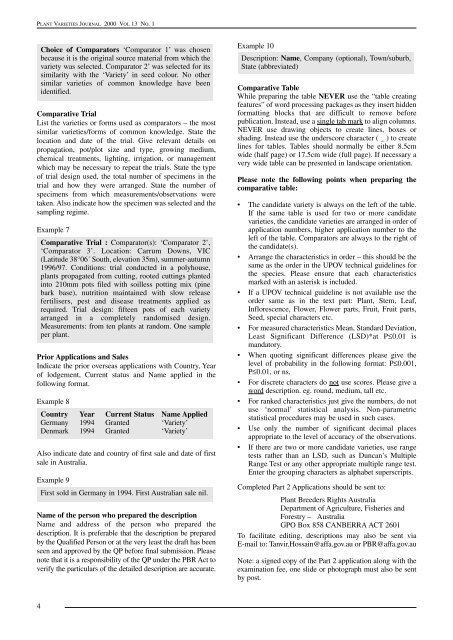53. Volume 13- Number 1 - IP Australia
53. Volume 13- Number 1 - IP Australia
53. Volume 13- Number 1 - IP Australia
You also want an ePaper? Increase the reach of your titles
YUMPU automatically turns print PDFs into web optimized ePapers that Google loves.
PLANT VARIETIES JOURNAL 2000 VOL <strong>13</strong> NO. 1<br />
Choice of Comparators ‘Comparator 1’ was chosen<br />
because it is the original source material from which the<br />
variety was selected. Comparator 2’ was selected for its<br />
similarity with the ‘Variety’ in seed colour. No other<br />
similar varieties of common knowledge have been<br />
identified.<br />
Comparative Trial<br />
List the varieties or forms used as comparators – the most<br />
similar varieties/forms of common knowledge. State the<br />
location and date of the trial. Give relevant details on<br />
propagation, pot/plot size and type, growing medium,<br />
chemical treatments, lighting, irrigation, or management<br />
which may be necessary to repeat the trials. State the type<br />
of trial design used, the total number of specimens in the<br />
trial and how they were arranged. State the number of<br />
specimens from which measurements/observations were<br />
taken. Also indicate how the specimen was selected and the<br />
sampling regime.<br />
Example 7<br />
Comparative Trial : Comparator(s): ‘Comparator 2’,<br />
‘Comparator 3’. Location: Carrum Downs, VIC<br />
(Latitude 38°06´ South, elevation 35m), summer-autumn<br />
1996/97. Conditions: trial conducted in a polyhouse,<br />
plants propagated from cutting, rooted cuttings planted<br />
into 210mm pots filed with soilless potting mix (pine<br />
bark base), nutrition maintained with slow release<br />
fertilisers, pest and disease treatments applied as<br />
required. Trial design: fifteen pots of each variety<br />
arranged in a completely randomised design.<br />
Measurements: from ten plants at random. One sample<br />
per plant.<br />
Prior Applications and Sales<br />
Indicate the prior overseas applications with Country, Year<br />
of lodgement, Current status and Name applied in the<br />
following format.<br />
Example 8<br />
Country Year Current Status Name Applied<br />
Germany 1994 Granted ‘Variety’<br />
Denmark 1994 Granted ‘Variety’<br />
Also indicate date and country of first sale and date of first<br />
sale in <strong>Australia</strong>.<br />
Example 9<br />
First sold in Germany in 1994. First <strong>Australia</strong>n sale nil.<br />
Name of the person who prepared the description<br />
Name and address of the person who prepared the<br />
description. It is preferable that the description be prepared<br />
by the Qualified Person or at the very least the draft has been<br />
seen and approved by the QP before final submission. Please<br />
note that it is a responsibility of the QP under the PBR Act to<br />
verify the particulars of the detailed description are accurate.<br />
Example 10<br />
Description: Name, Company (optional), Town/suburb,<br />
State (abbreviated)<br />
Comparative Table<br />
While preparing the table NEVER use the “table creating<br />
features” of word processing packages as they insert hidden<br />
formatting blocks that are difficult to remove before<br />
publication. Instead, use a single tab mark to align columns.<br />
NEVER use drawing objects to create lines, boxes or<br />
shading. Instead use the underscore character ( _ ) to create<br />
lines for tables. Tables should normally be either 8.5cm<br />
wide (half page) or 17.5cm wide (full page). If necessary a<br />
very wide table can be presented in landscape orientation.<br />
Please note the following points when preparing the<br />
comparative table:<br />
• The candidate variety is always on the left of the table.<br />
If the same table is used for two or more candidate<br />
varieties, the candidate varieties are arranged in order of<br />
application numbers, higher application number to the<br />
left of the table. Comparators are always to the right of<br />
the candidate(s).<br />
• Arrange the characteristics in order – this should be the<br />
same as the order in the UPOV technical guidelines for<br />
the species. Please ensure that each characteristics<br />
marked with an asterisk is included.<br />
• If a UPOV technical guideline is not available use the<br />
order same as in the text part: Plant, Stem, Leaf,<br />
Inflorescence, Flower, Flower parts, Fruit, Fruit parts,<br />
Seed, special characters etc.<br />
• For measured characteristics Mean, Standard Deviation,<br />
Least Significant Difference (LSD)*at P≤0.01 is<br />
mandatory.<br />
• When quoting significant differences please give the<br />
level of probability in the following format: P≤0.001,<br />
P≤0.01, or ns.<br />
• For discrete characters do not use scores. Please give a<br />
word description. eg. round, medium, tall etc.<br />
• For ranked characteristics just give the numbers, do not<br />
use ‘normal’ statistical analysis. Non-parametric<br />
statistical procedures may be used in such cases.<br />
• Use only the number of significant decimal places<br />
appropriate to the level of accuracy of the observations.<br />
• If there are two or more candidate varieties, use range<br />
tests rather than an LSD, such as Duncan’s Multiple<br />
Range Test or any other appropriate multiple range test.<br />
Enter the grouping characters as alphabet superscripts.<br />
Completed Part 2 Applications should be sent to:<br />
Plant Breeders Rights <strong>Australia</strong><br />
Department of Agriculture, Fisheries and<br />
Forestry – <strong>Australia</strong><br />
GPO Box 858 CANBERRA ACT 2601<br />
To facilitate editing, descriptions may also be sent via<br />
E-mail to: Tanvir.Hossain@affa.gov.au or PBR@affa.gov.au<br />
Note: a signed copy of the Part 2 application along with the<br />
examination fee, one slide or photograph must also be sent<br />
by post.<br />
4

















